Parisian Walkways: Passage Jouffroy, the Historic Covered Shopping Arcade

It is, and always has been, one of the most popular covered arcades in the French capital. Jeffrey T Iverson meets the people who give the Passage Jouffroy its unique air
Stepping into one of Paris’s historic covered shopping arcades for the first time can be a moving experience, but with Passage Jouffroy, it’s often a completely unexpected one. So it was for Nathalie Dijon some years ago, the day she first visited the Musée Grévin wax museum at 10 boulevard Montmartre. After navigating her way through this rather strange and engrossing tour into France’s tumultuous past and the cult of celebrity, she’d learn, like 800,000 other visitors annually, that one doesn’t exit the museum where one enters it. “When we finally left, we were rather confounded to find ourselves stepping not back out onto the boulevard, but into the middle of a 19th-century covered passageway,” she recalls. Blinking in the sunlight pouring down from the soaring, sculpted glass roof, surrounded by beautiful boutiques with elaborate wood panelling and enticing window displays, Dijon half wondered if she wasn’t still in a museum.
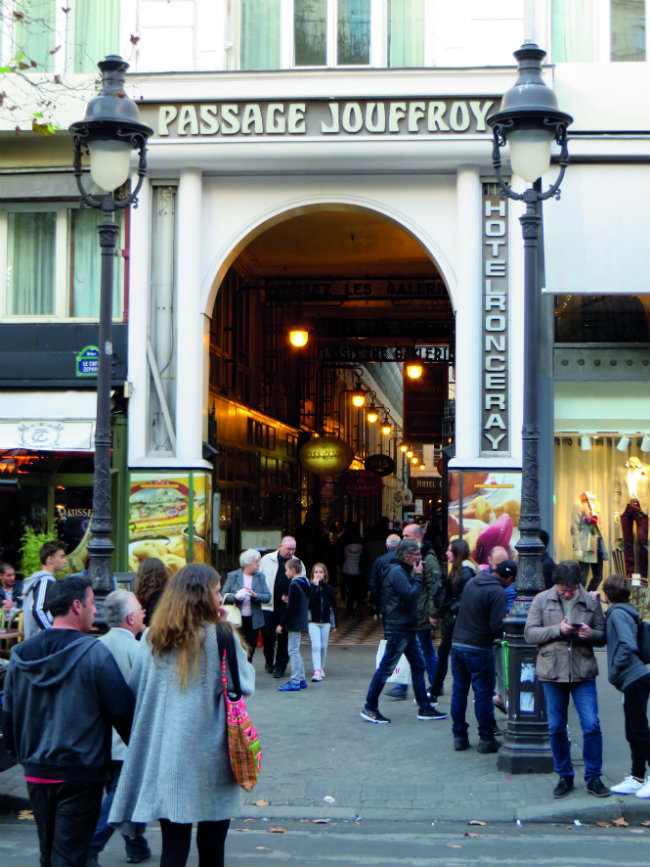
Passage Jouffroy. Photo: Jeffrey T Iverson
“It’s truly a world apart,” Dijon says of Jouffroy. “I often say it’s like being in a cocoon. From the moment you step into this passageway, you completely forget everything outside. It might be miserable weather, but we wouldn’t know here in our cocoon.”
Walking through it that first time, Dijon stumbled into a boutique that would change her life, a shop called Pain d’Épices. Founded nearly half a century ago, Pain d’Épices is a dream boutique for children and the young at heart, offering traditional wooden and tin toys, puppets and stuffed animals, but especially an entire world of doll’s houses and the miniature figures, furniture and objects that ll them – from garden tools and croquet sets, to rotisserie chickens and croissants. It was a world that impassioned Dijon, and the founder, Françoise Blinderman, took notice. In 2012, when Blinderman was ready to retire, she sold the shop to her.
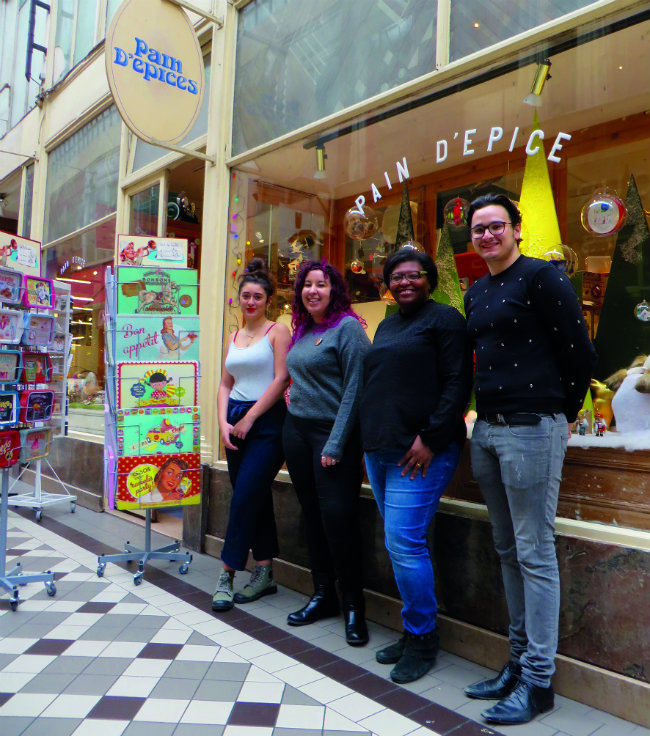
Pain d’Épices. Photo: Jeffrey T Iverson
Five years later, as Passage Jouffroy celebrated its 160th anniversary, Dijon was one of an ensemble of proprietors of one-of-a-kind shops which together have maintained the timeless spirit of this storied shopping arcade. Their passions for miniatures, antique canes, baroque decorations, rare books, art restoration, and French pastries are the fuel that fires Passage Jouffroy’s unique allure. It is a place that has never quite been of the present, or even of this city, but rather a universe unto itself.
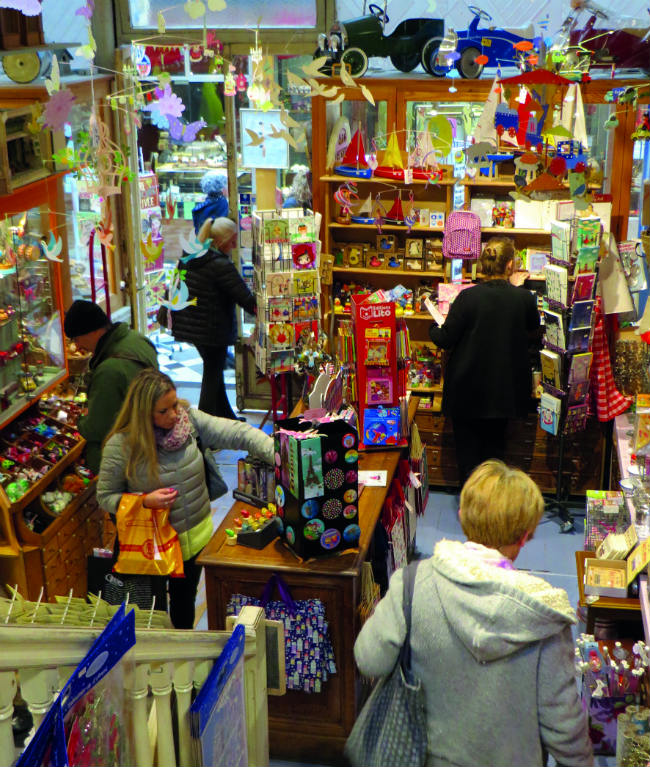
Pain d’Épices. Photo: Jeffrey T Iverson
If the 19th century was the golden age of the Parisian covered passageway, with dozens built in the first half of the century, then Passage Jouffroy represented its zenith, in size, architectural complexity, and popularity. Jouffroy benefited from a prime location on the Grands Boulevards – the wide avenues lined with cafés, luxury hotels and modern attractions which emerged where Louis XIV had felled the old Charles V and Louis XIII city walls to become a veritable crossroads of Paris’s beau monde. In the 1800s, the network of covered arcades was so developed one could ambulate on a rainy day from Palais-Royal to the Grands Boulevards and hardly get wet. And when Comte Félix de Jouffroy-Gonsans and his fellow investors inaugurated Passage Jouffroy in 1847, that promenade extended 140 metres further.
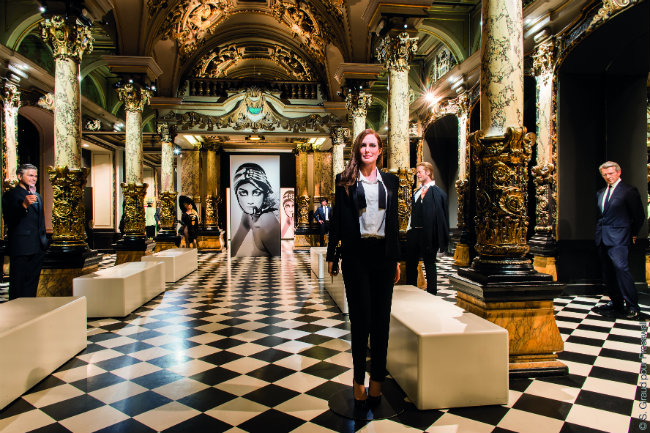
The Musée Grévin’s Hall of Columns. Courtesy of the Musée Grévin
Indeed, the arcade was built at 10 boulevard Montmartre so as to pick up directly across the street from the well-trodden Passage des Panoramas. Jouffroy would follow both the older arcade’s axis and its recipe for success. Panoramas boasted architectural beauty, cutting-edge innovation (the first gas lights in France), and a heavy dose of spectacle – its name comes from an attraction built on the site at its opening in 1800: two large rotundas, created by the American inventor and engineer Robert Fulton, displaying panoramic paintings of famous cities.
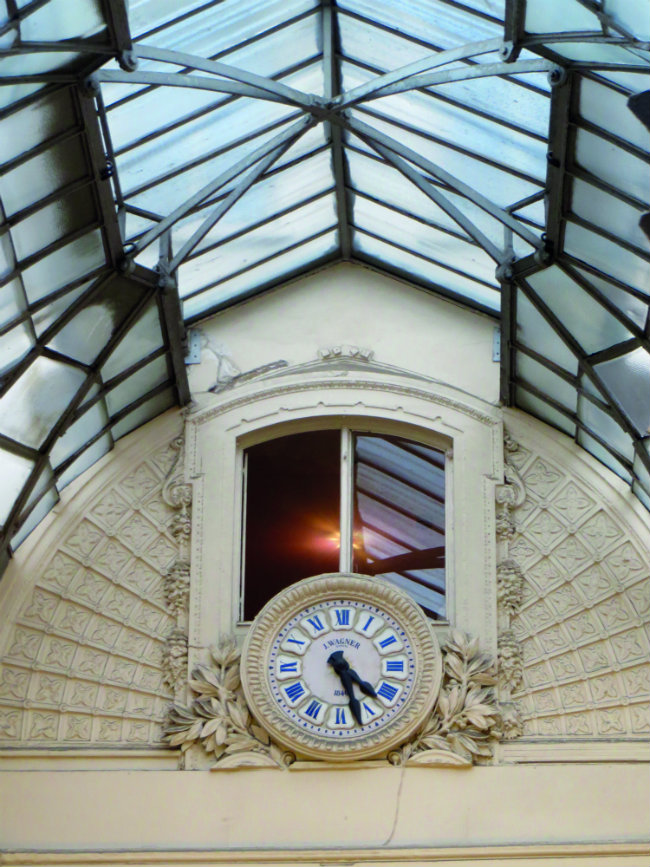
Passage Jouffroy. Photo: Jeffrey T Iverson
Passage Jouffroy came with its own charms and technological revolutions, as the first arcade built entirely in iron and glass, with only decorative elements in wood. The iron frame allowed for the creation of a vast, rounded glass roof to flood the space with natural light, topped with a second V-shaped glass roof to protect the former and allow for perfect ventilation – a necessity, since Jouffroy was the first covered passage with gas heating installed in its floors.
As for spectacle, there were luxurious shops including milliners, tailors, hairdressers, glove makers; avant-garde restaurants, a dance hall, a puppet theatre, and an institution which would become the district’s biggest attraction when it opened in 1882, the Musée Grévin wax museum. The brainchild of Le Gaulois newspaper director Arthur Meyer and the caricaturist Alfred Grévin, the museum allowed the public – in a pre-photography era – to see in 3D people they’d read about and figures from French history. Through the years, Grévin’s halls and theatres presented many innovations, from lament light bulbs and X-rays to the projection of the world’s first animated film with Charles-Émile Reynaud’s Théâtre Optique.
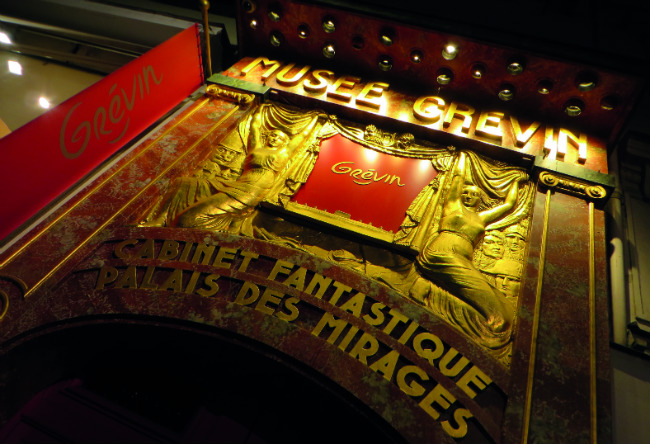
Musée Grévin. Photo: Jeffrey T Iverson
The Parisian public flocked to Passage Jouffroy from day one. In his 1867 Les Plaisirs de Paris: Guide Pratique, Alfred Delvau described a passageway “so awash with crowds of flâneurs that, each day, from four in the afternoon, one needs to use one’s elbows vigorously to make one’s way through the throng, who move in thick shoals like herrings in the Channel. Why so many people? It’s a place for rendezvous and promenades: a place we look forward to, and once strolling there, we forget all our worries.”
Today, a vibrant symbol of that golden age endures at No. 34 of the passageway: the phenomenal cane and umbrella shop Galerie Fayet. “Passage Jouffroy is a pure creation of the 19th century,” says the boutique’s Franco-Japanese director, Ako Sato. “Paris was muddy, dark and dirty, but here there was light, and people came to see and be seen. They dressed to the nines, and the cane was the symbol of this Belle-Époque elegance. So I’m proud to carry the torch of that 19th-century tradition here.”
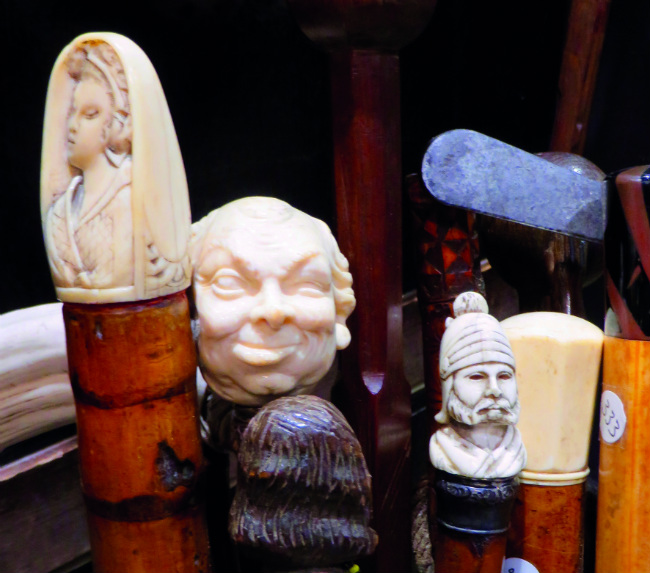
Antique canes at Galerie Fayet. Photo: Jeffrey T Iverson
The boutique offers both refined modern canes from the last manufacturer in France – Cannes Fayet, founded in 1909 – and a breathtaking array of antique canes inherited from the Segas brothers who opened the boutique in the 1970s. Many hide secrets, beyond the stereotypical sword cane – there’s the one originally made for Bonaparte loyalists, whose ornamental head casts a shadow of Napoleon’s profile; and another for Toulouse-Lautrec, concealing a flask and two glasses for absinthe.
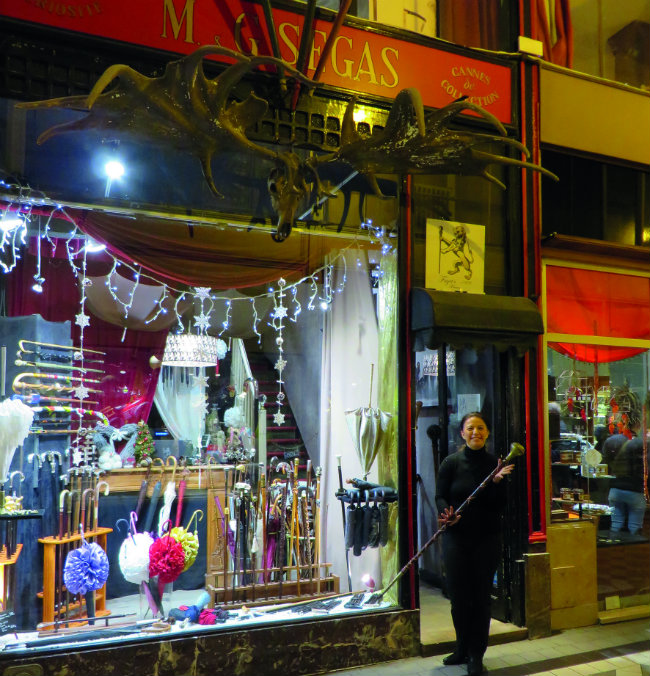
Galerie Fayet. Photo: Jeffrey T Iverson
At No. 24, the Maison du Roy curates a collection of decorative objects from another century, the 18th. After years of dealing in 18th-century furniture and paintings at the Saint-Ouen antiques market, Carole and Pascal Lemoine decided there were still too many objects from that era they couldn’t find, especially fragile ones in textiles and glass. So, they decided to make them themselves, commissioning exquisite 18th-century-inspired creations from artisans in Austria, Italy and India, and presenting them throughout their two-floor boutique alongside antique furnishings to create an entire, quite scintillating, baroque universe.
“It’s a boutique, like the passage itself, that asks us to slow down, pause, and explore, for there is so much to discover,” says Carole. “Our passion is to create an ambiance which awakens all the senses, from the spectacle of light and glass you see all around, to the period music in the background, to the aromas from the candles we commission from parfumiers in Grasse.”
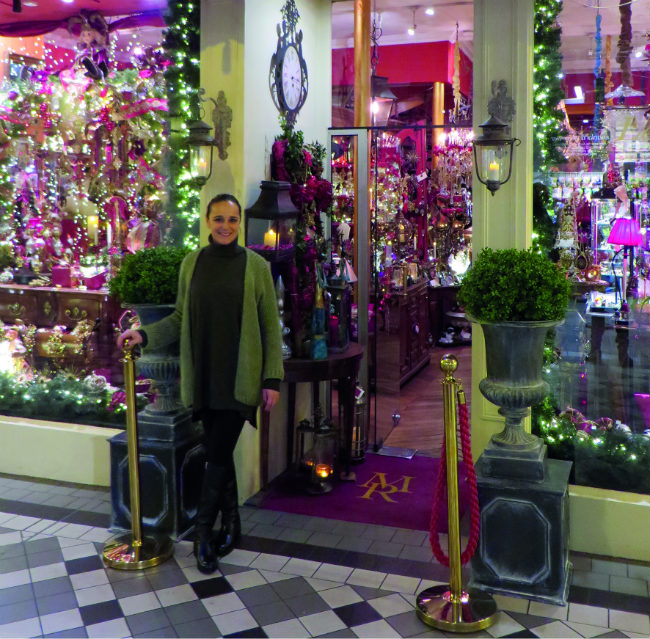
Maison du Roy. Photo: Jeffrey T Iverson
It seems this remove from the bustle and noise outside that the passage provides attracts certain types of entrepreneurs – those with businesses ever so slightly out of sync with the modern world. “Le Valentin is kind of a timeless place,” says Odile Yver, who became owner of this renowned tea room, chocolate and pastry shop in 2010. “In an era when all we have are concept stores, it’s the contrary of all that. If we wanted to create several more Valentins we could, but that’s not our mentality. We just wanted to make something authentic, a place for gourmands, where people don’t feel pressed for time.”
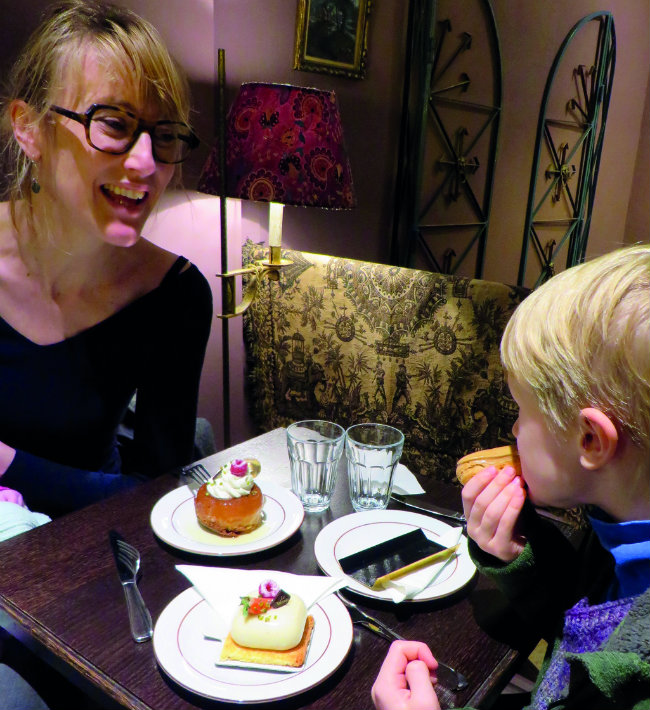
Le Valentin. Photo: Jeffrey T Iverson
But with the volume of foot traffic the passage enjoys today, it’s hard to keep the modern world out entirely. When Passage Jouffroy’s Asian import shop, Palais Oriental, closed after 56 years in 2016, the British multinational retailer Marks & Spencer snapped up the 800m2 space to open a food market. For many business owners in the passageway, the big brand incursion came as a worrisome development. “It’s the same danger that threatens all of Paris today,” says Jean-Luc Langlaude, owner of Librarie du Passage. “We’re going to have to fight to prevent the ‘Disneylandisation’ of the passageways. For now, there’s still a core of businesses here that have real identities, and want to preserve the passageway. But I don’t know how long it will last.”
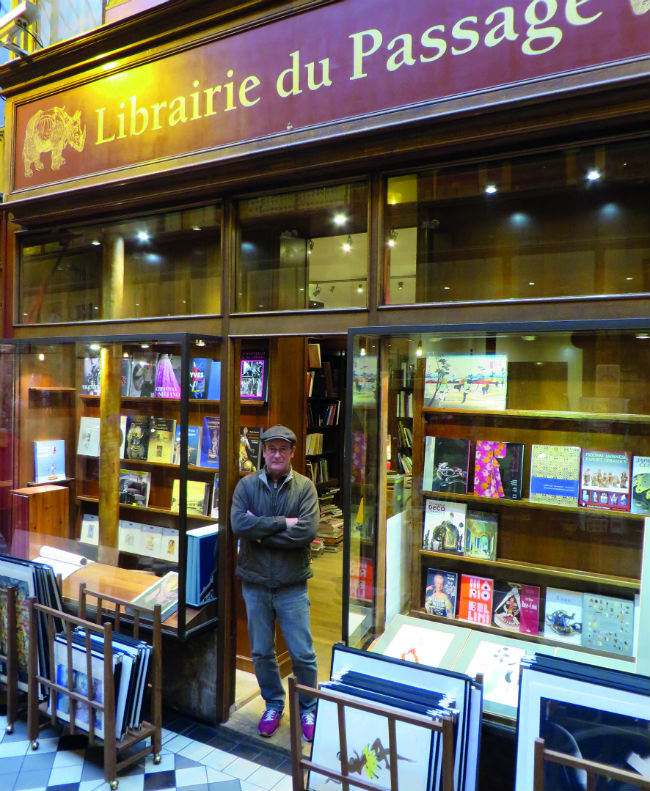
Librarie du Passage. Photo: Jeffrey T Iverson
And yet the passageway also provides proof that old businesses can subtly adapt and thrive in modern times. Hôtel Chopin, at No. 46, has no lock on its front door – because it has never closed since 1846. And Librarie du Passage, founded in 1850, is one of the oldest bookstores in Paris. “When we bought it 20 years ago, it was a bookstore that was beginning to die,” Langlaude recalls. “So we specialised it in fine arts reference books to benefit from the micro-climate created by the nearby Drouot auction house.” (Drouot benefits others passage dwellers too, such as Claudine Manuceau of Galerie & Atelier Jouffroy at No. 63, a talented and contentedly busy art restorer). At the same time, to attract a wider clientele, Langlaude has developed an expertise in turn-of-the-century French and Russian posters, which he has printed, on traditional lithography presses, with rich colours on beautiful paper – and which now sell like hotcakes.
“The passageway will continue to modernise bit by bit, but we’ll continue to celebrate its history,” says Galerie Fayet’s Ako Sato. “Because, from the beginning, the Passage Jouffroy has been a place of rare luxuries, foods and amusement, it’s a place that makes people dream.” Sato shows us one of her favourite antique canes, a woman’s cane painted in green, once owned by a mysterious, and undoubtedly elegant, lady. Sato unscrews the top to reveal a concealed manicure set, complete with lip rouge and a perfume bottle. She holds the bottle up, to show that its aroma is still perceptible, and still transporting. Sato smiles: “That’s the fragrance of the 19th century.”
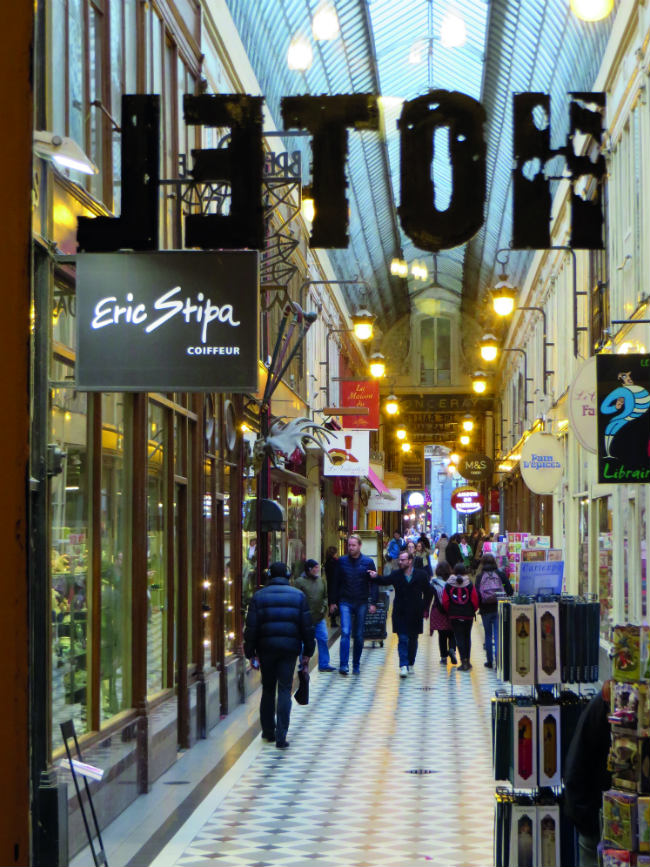
Hotel Chopin. Photo: Jeffrey T Iverson
FAVOURITE ADDRESSES
La Maison du Roy, 24 Passage Jouffroy, Tel. +33 (0)1 45 51 29 94
Founded by two 18th-century antique specialists, La Maison du Roy immerses visitors in a world of boudoirs, castles and costume balls. Offering genuine 18th-century artwork, furniture and curiosities, as well as handmade decorations in the same spirit, the boutique glistens with candles and hand-blown glass. Come Christmas, it’s simply the most scintillatingly baroque place in Paris.
Pain d’Épices, 29 Passage Jouffroy, Tel. +33 (0)1 47 70 08 68
Since 1972, generations of children in love with doll’s house miniatures, handmade wooden toys and quality stuffed animals and dolls, have discovered their heaven on earth in the two-floors of Pain d’Épices. Named for the favourite tea-time treat of French enfants a half-century ago, and filled with vintage toys and candies, the shop is sure to give a nostalgia rush to adults too.
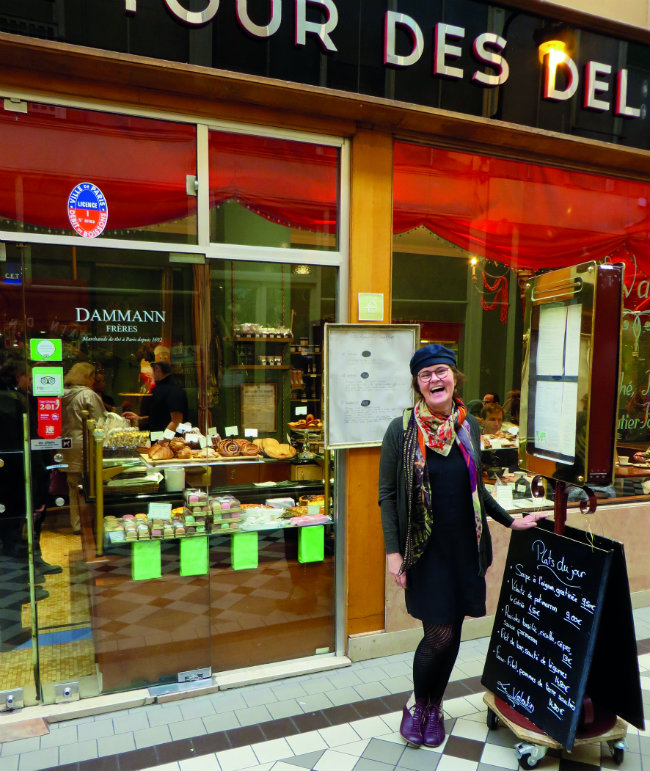
Le Valentin. Photo: Jeffrey T Ivreson
Le Valentin, 30 Passage Jouffroy, Tel. +33 (0)1 47 70 88 50
For decades, one of the best kept secrets for pastry lovers in Paris has been a salon de thé in Passage Jouffroy. A bastion of traditional French pastries and viennoiseries, made entirely from scratch, Le Valentin is a charming place to enjoy breakfast, lunch, or just a Mont Blanc pastry and some fine Dammann Frères tea while watching the world pass by in the arcade outside.
Galerie Fayet, 34 Passage Jouffroy, Tel. +33 (0)1 47 70 89 65
The cane may evoke old age and infirmity for some, yet Galerie Fayet doesn’t sell medical wares, they sell works of art. Their antique and modern canes are windows into the elegance of the Belle Époque and the heights of human ingenuity and craftsmanship. Made from ivory and gold, ebony and rosewood, they often have secret functions, from swords and violins to pipes and picnic sets.
Hotel Chopin, 46 Passage Jouffroy, Tel. +33 (0)1 47 70 58 10
Named for the Polish pianist who fell in love with Paris, and with George Sand, while living in this very neighbourhood, Hôtel Chopin is a place for romantics. Open since 1846, it’s among the city’s oldest hotels, and the only one built inside an arcade. With views over rooftops and no street-facing rooms, few hotels in Paris can boast such calm, such reasonable prices and such charm.
Librairie du Passage, 48-62 Passage Jouffroy, Tel. +33 (0)1 56 03 94 10
Founded in 1850, one of Paris’s oldest bookstores is thriving still. How? By managing to be hyper-specialised while offering something for everyone. Drouot auction house experts come for their vast collection of fine arts and jewellery reference books; discerning bibliophiles come for their rare monographs; and their bargain art books and gorgeous 1900s lithographs are loved by all.
From France Today magazine
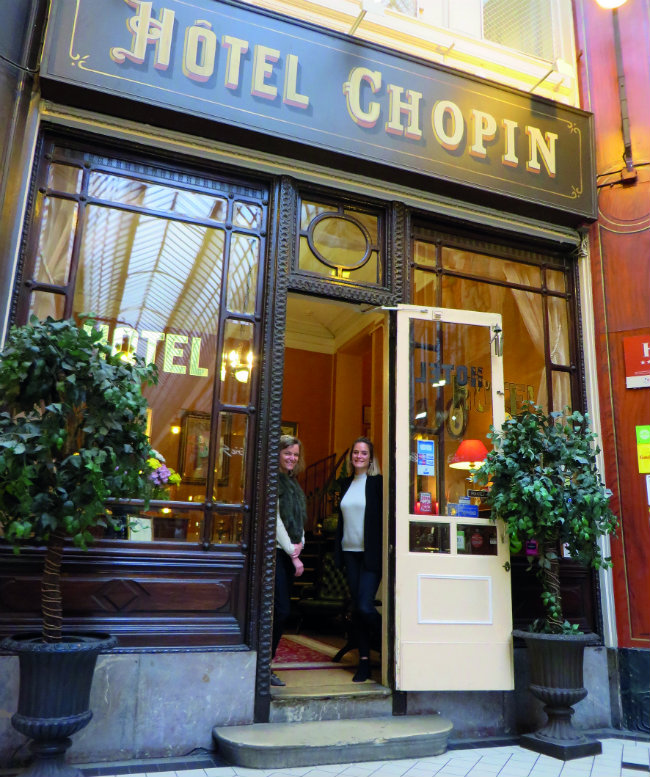
Hotel Chopin. Photo: Jeffrey I Iverson
Share to: Facebook Twitter LinkedIn Email
Leave a reply
Your email address will not be published. Required fields are marked *




REPLY